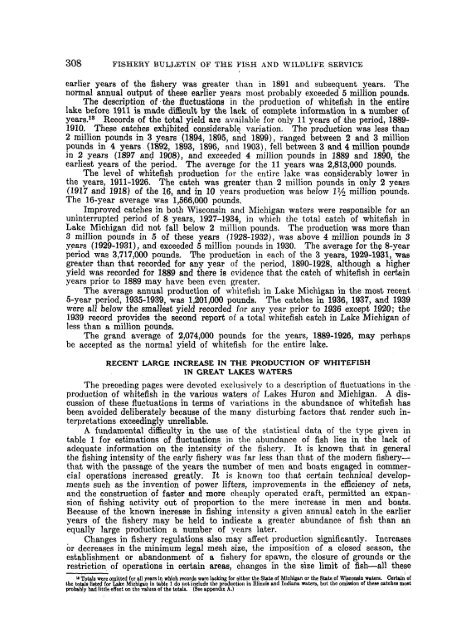Fishery bulletin of the Fish and Wildlife Service - NOAA
Fishery bulletin of the Fish and Wildlife Service - NOAA
Fishery bulletin of the Fish and Wildlife Service - NOAA
Create successful ePaper yourself
Turn your PDF publications into a flip-book with our unique Google optimized e-Paper software.
308 FISHERY BULLETIN OF THE FISH AND WILDLIFE SERVICE<br />
earlier years <strong>of</strong> <strong>the</strong> fishery was greater than in 1891 <strong>and</strong> subsequent years. The<br />
normal annual output <strong>of</strong> <strong>the</strong>se earlier years most probably exceeded 5 million pounds.<br />
The description <strong>of</strong> <strong>the</strong> fluctuations in <strong>the</strong> production <strong>of</strong> whitefish in <strong>the</strong> entire<br />
lake before 1911 is made difficult by <strong>the</strong> lack <strong>of</strong> complete information in a number <strong>of</strong><br />
years. 18 Records <strong>of</strong> <strong>the</strong> total yield are available for only 11 years <strong>of</strong> <strong>the</strong> period, 1889-<br />
1910. These catches exhibited considerable variation. The production was less than<br />
2 million pounds in 3 years (1894, 1895, arid 1899), ranged between 2 <strong>and</strong> 3 million<br />
pounds in 4 years (1892, 1893, 1896, <strong>and</strong> 1903), fell between 3 <strong>and</strong> 4 million pounds<br />
in 2 years (1897 <strong>and</strong> 1908), <strong>and</strong> exceeded 4 million pounds in 1889 <strong>and</strong> 1890, <strong>the</strong><br />
earliest years <strong>of</strong> <strong>the</strong> period. The average for <strong>the</strong> 11 years was 2,813,000 pounds.<br />
The level <strong>of</strong> whitefish production for <strong>the</strong> entire lake was considerably lower in<br />
<strong>the</strong> years, 1911-1926. The catch was greater than 2 million pounds in only 2 years<br />
(1917 <strong>and</strong> 1918) <strong>of</strong> <strong>the</strong> 16, <strong>and</strong> in 10 years production was below 1% million pounds.<br />
The 16-year average was 1,566,000 pounds.<br />
Improved catches in both Wisconsin <strong>and</strong> Michigan waters were responsible for an<br />
uninterrupted period <strong>of</strong> 8 years, 1927-1934, in which <strong>the</strong> total catch <strong>of</strong> whitefish in<br />
Lake Michigan did not fall below 2 million pounds. The production was more than<br />
3 million pounds in 5 <strong>of</strong> <strong>the</strong>se years (1928-1932), was above 4 million pounds in 3<br />
years (1929-1931), <strong>and</strong> exceeded 5 million pounds in 1930. The average for <strong>the</strong> 8-year<br />
period was 3,717,000 pounds. The production in each <strong>of</strong> <strong>the</strong> 3 years, 1929-1931, was<br />
greater than that recorded for any year <strong>of</strong> <strong>the</strong> period, 1890-1928, although a higher<br />
yield was recorded for 1889 <strong>and</strong> <strong>the</strong>re is evidence that <strong>the</strong> catch <strong>of</strong> whitefish in certain<br />
years prior to 1889 may have been even greater.<br />
The average annual production <strong>of</strong> whitefish in Lake Michigan in <strong>the</strong> most recent<br />
5-year period, 1935-1939, was 1,201,000 pounds. The catches in 1936, 1937, <strong>and</strong> 1939<br />
were all below <strong>the</strong> smallest yield recorded for any year prior to 1936 except 1920; <strong>the</strong><br />
1939 record provides <strong>the</strong> second report <strong>of</strong> a total whitefish catch in Lake Michigan <strong>of</strong><br />
less than a million p.ounds.<br />
The gr<strong>and</strong> average <strong>of</strong> 2,074,000 pounds for <strong>the</strong> years, 1889-1926, may perhaps<br />
be accepted as <strong>the</strong> normal yield <strong>of</strong> whitefish for <strong>the</strong> entire lake.<br />
RECENT LARGE INCREASE IN THE PRODUCTION OF WHITEFISH<br />
IN GREAT LAKES WATERS<br />
The preceding pages were devoted exclusively to a description <strong>of</strong> fluctuations in <strong>the</strong><br />
production <strong>of</strong> whitefish in <strong>the</strong> various waters <strong>of</strong> Lakes Huron <strong>and</strong> Michigan. A discussion<br />
<strong>of</strong> <strong>the</strong>se fluctuations in terms <strong>of</strong> variations in <strong>the</strong> abundance <strong>of</strong> whitefish has<br />
been avoided deliberately because <strong>of</strong> <strong>the</strong> many disturbing factors that render such interpretations<br />
exceedingly unreliable.<br />
A fundamental difficulty in <strong>the</strong> use <strong>of</strong> <strong>the</strong> statistical data <strong>of</strong> <strong>the</strong> type given in<br />
table 1 for estimations <strong>of</strong> fluctuations in <strong>the</strong> abundance <strong>of</strong> fish lies in <strong>the</strong> lack <strong>of</strong><br />
adequate information on <strong>the</strong> intensity- <strong>of</strong> <strong>the</strong> fishery. It is known that in general<br />
<strong>the</strong> fishing intensity <strong>of</strong> <strong>the</strong> early fishery was far less than that <strong>of</strong> <strong>the</strong> modern fishery-—<br />
that with <strong>the</strong> passage <strong>of</strong> <strong>the</strong> years <strong>the</strong> number <strong>of</strong> men <strong>and</strong> boats engaged in commercial<br />
operations increased greatly. It is known too that certain technical developments<br />
such as <strong>the</strong> invention <strong>of</strong> power lifters, improvements in <strong>the</strong> efficiency <strong>of</strong> nets,<br />
<strong>and</strong> <strong>the</strong> construction <strong>of</strong> faster <strong>and</strong> more cheaply operated craft, permitted an expansion<br />
<strong>of</strong> fishing activity out <strong>of</strong> proportion to <strong>the</strong> mere increase in men <strong>and</strong> boats.<br />
Because <strong>of</strong> <strong>the</strong> known increase in fishing intensity a given annual catch in <strong>the</strong> earlier<br />
years <strong>of</strong> <strong>the</strong> fishery may be held to indicate a greater abundance <strong>of</strong> fish than ah<br />
equally large production a number <strong>of</strong> years later.<br />
Changes in fishery regulations also may affect production significantly. Increases<br />
or decreases in <strong>the</strong> minimum legal mesh size, <strong>the</strong> imposition <strong>of</strong> a closed season, <strong>the</strong><br />
establishment or ab<strong>and</strong>onment <strong>of</strong> a fishery for spawn, <strong>the</strong> closure <strong>of</strong> grounds or <strong>the</strong><br />
restriction <strong>of</strong> operations in certain areas, changes in <strong>the</strong> size limit <strong>of</strong> fish—all <strong>the</strong>se<br />
u Totals were omitted for all years in which records wire lacking for ei<strong>the</strong>r <strong>the</strong> State <strong>of</strong> Michigan or <strong>the</strong> State <strong>of</strong> Wisconsin waters. Certain <strong>of</strong><br />
<strong>the</strong> totals listed for Lake Michigan in table 1 do not include <strong>the</strong> production in Illinois <strong>and</strong> Indiana waters, but <strong>the</strong> omission <strong>of</strong> <strong>the</strong>se catches most<br />
probably had little effect on <strong>the</strong> values <strong>of</strong> <strong>the</strong> totals. (See appendix A.)

















